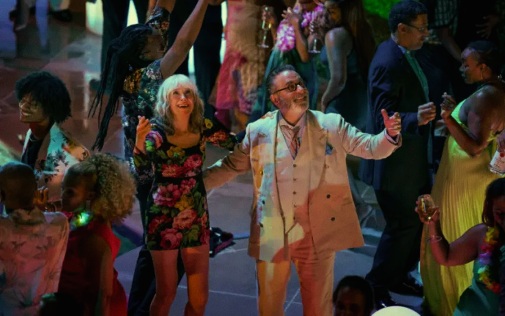
Where does one draw the line between period and contemporary costume design? It's hard to tell, and sometimes, it depends on the intentionality behind a given sartorial choice. Some filmmakers aim to capture the specificity of time and place, even when chronological proximity would excuse some adaptations to current sensibilities. Others forego that exactitude altogether. And then there's the way even the Costume Design Guild muddies the waters. How is the early 90s style of Rent considered period in 2005, but Precious' 1987-set narrative is still contemporary in 2009? All this to say that, for this article's purpose, let's interpret Pain Hustlers' wardrobe as a work of contemporary costume design. An outstanding one at that…

Though she's most famous for her Tim Burton fantasies and Rob Marshall musicals, Colleen Atwood's career started in the relatively humbler world of contemporary style. Her first significant collaborator was Jonathan Demme, whose 80s comedies Atwood outfitted with an eye toward character idiosyncrasies. The peak of their work together would come with The Silence of the Lambs, a masterpiece of horror costuming, full of iconic sights and perverse wit. But that's in the past. Recently, the designer has consolidated her dominion over big-budget fantastical fashions – the Fantastic Beasts franchise, Burton's Wednesday show, and The Little Mermaid remake come to mind.
Looking at those titles, one would be forgiven for assuming Atwood would never return to the pared-down milieus of yore.
In comes Pain Hustlers, another one of those puerile Big Short wannabes, differentiating itself from the bunch by tackling the opioid crisis rather than the world of finance and other business. Not that David Yates' latest is an exceptionally exact true crime exercise. After all, it centers on a fictional character – Emily Blunt's Liza – who comes into a pharmaceutical company around 2011 and makes millions. It only cost her soul to get there. It's her arc that Atwood paid most attention to while designing the picture's wardrobe, delineating a careful evolution encompassing changing finances alongside a rotting conscience.
The protagonist starts in faded shades, as if all her clothes had been put through the washer one time too many. Without hammering the point to exhaustion, it's a visual indication of her present struggle, going from job to job, including a stint as a strip club's least enthusiastic dancer. When she gets an opportunity from Peter Brenner – a particularly douche patron, played by Chris Evans – color seeps into her quotidian. At first, it's a façade for business, projecting confidence before the genuine thing blossoms inside one's heart. In due time, there's no need to fake it, for success is within reach – it's here, terrible and all-consuming.
Slowly, her fashion gets bolder, colors shocking our eyeballs while sharp cuts signify a newly-stuffed bank account. Outdated fits from the sales rack give way to more modern pieces, higher-end, and sometimes even from big-name designers. Moreover, these choices are about power, not classical elegance or good taste.


At her mercenary peak, Liza is an explosion of bright red, million-dollar green, and saffron yellow, white suiting with diamante accents, mermaid sequins in gold. But then, as the reality of what she's been doing becomes impossible to ignore, her palette decomposes into darker tones, verging on grayscale. The outfits still emanate richness, but they're now thorns pointing inwards, digging into her sense of self. The veneer of sophistication that comes with hoarded wealth rusts, forming a patina of palpable disappointment. Guilt is given material form, every exuberant touch another reminder of wrongs done. The tacky lacing detail over a pencil skirt feels almost accusatory.

Even beyond Liza, Pain Hustlers remains a showcase for Atwood's brand of genius, focusing on getting the geographic and cultural quirks of the setting just right. Central Florida is seen as a place where working-class people live in downtrodden community, struggling to make ends meet while still enjoying the pleasures of everyday, fighting their aches and anguishes. Even background players can sport an eye-catching piece full of character, though we never hear from them. These choices inform a plurality that frames the central story and serves as a necessary counterpoint to the executives who make money by preying upon the desperate.


Atwood based her work on photographic research and a bunch of thrifted clothes, amassing a bounty of garments with long lives before their time on screen. Well, that's for the common man and Liza's early days. For Evans, Andy Garcia, and a foppish Brian d'Arcy James, it's all about peacocking. Notice the older gentlemen's penchant for gold jewelry, Gucci belt buckles, bright ties, and an ugly machine-lace shirt worn for the doctor's office. In the costume designer's own words, these figures and their arcs represent an exercise closer to anti-style. Similar things could be said about Catherine O'Hara as Liza's mother, a woman whose wardrobe seems stuck a couple of decades in the past before she can splurge on Italian luxury after selling enough drugs to kill a generation. It's downright obscene, ugly – and that's the point.

You can find Pain Hustlers streaming exclusively on Netflix.


